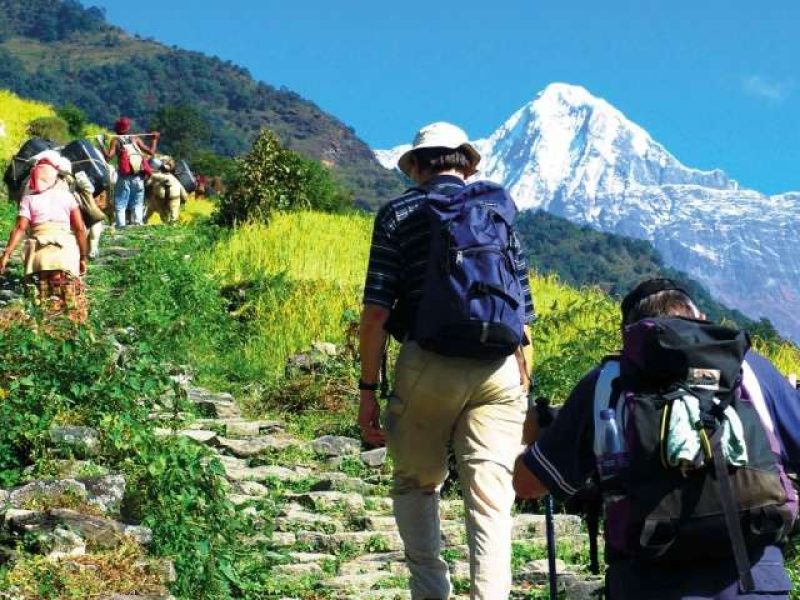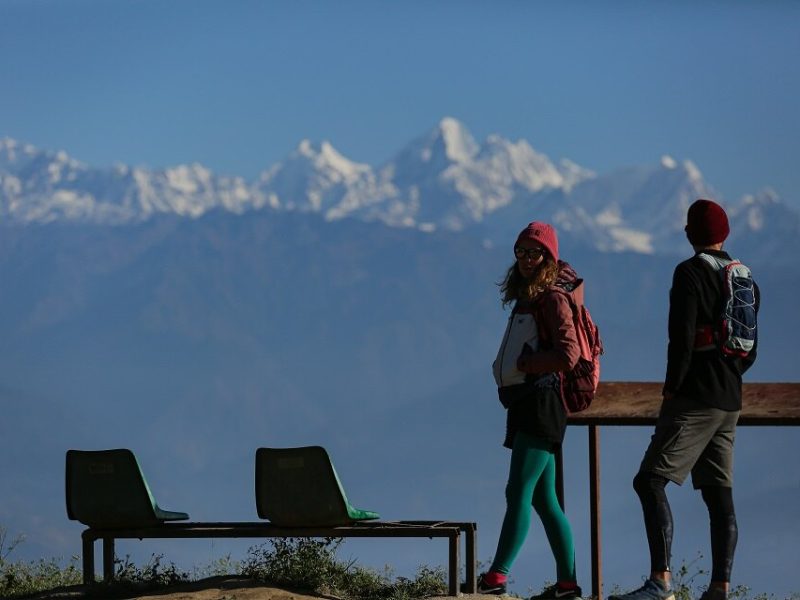Tourist arrivals in Nepal are increasing dramatically in 2023 driven by a significant flow of visitors from India and the United States. Nepal experienced a significant amount of tourism. Nepal is known for being the home of 8 highest peaks in the world. Nepali culture is rich in history and tradition. Nepal is full of ancient temples and monasteries which captivates visitors to visit Nepal. The people of Nepal are warm and welcoming people. For future travelers it is a perfect reason to visit Nepal.
Nepal welcomed 10 lakh 14 thousand 876 tourists in 2023. In comparison to 2022 there is an increase of 4,728 tourists from the 6,148 tourists. The increasing number of Indian, American and Chinese tourists as well as the opening of China’s borders contributes to the growth of Nepal’s tourism sector.
In 2023, tourists arrived from India, America and China in a great number causing an increase in the tourism sector. 3,19,936 Indians, 100,357 Americans and 60,878 Chinese visited Nepal for tourism. Despite the COVID-19 pandemic Nepal has achieved a third consecutive year of tourist arrivals exceeding 10 lakh.
In 2024 the experts anticipate the tourism sector is going to be increased as the government’s target of 10 lakh tourists for 2023 was met. Prime Minister Prachanda aims to double arrivals to 20 lakhs promoting infrastructure development and a positive outlook for the tourism industry.
Importance Of Tourism In Nepal
Tourism plays an important role in Nepal’s economy. It helps Nepal’s GDP to be increased, cultural exchange, environmental preservation and global recognition. In sectors like hospitality, transportation and entertainment, increasing economic growth and improving living standards it boosts employment. Tourists contribute to global harmony by fostering tolerance, empathy and respect for diversity.
It also supports environmental conservation with Nepal’s landscapes being a key focus. The industry also elevates Nepal’s international profile, positioning it as a coveted destination. Marketing campaigns, cultural festivals and adventure activities attract travelers worldwide, boosting diplomatic and cultural relations.
As Nepal utilizes its tourism potential, it holds the key to a future of prosperity, sustainability and unparalleled experiences for visitors and residents.
Tourist Arrivals In Nepal | A Historic Milestone
In 2023, compared to previous records Nepal’s tourism industry experienced a historic increment. Improvements in infrastructure, enhanced accessibility of remote regions and enhancing promotional efforts are the main reasons for increment in the tourism sector of Nepal.
The main contribution to the increment of tourist arrivals is the country’s political stability and peaceful environment. The country’s unique attractions and experiences are attracting male visitors, which has boosted tourism visibility.
Improved infrastructure, increased promotional efforts and favorable geopolitical conditions has contributed to the increase of tourist arrival in Nepal. By offering unforgettable experiences amidst its breathtaking landscapes and rich cultural heritage Nepal continuously attracts travelers.
American Tourists | Emerging Trend in Nepal’s Tourism
American tourists have been increasing in Nepal. The increment helps in the changing demographic of the country’s tourism industry. Adventure fans are attracted by the country’s diverse offerings including trekking in the Himalayas and exploring ancient cities.

The American tourists are attracted to the country’s rich cultural heritage, including UNESCO World Heritage sites. The main reasons for Americans visiting Nepal is that they can immerse in Nepal’s unique culture such as participating in traditional festivals and interacting with local communities.
American tourists highlight Nepal’s growing appeal as a destination offering adventure, culture and natural beauty is now a growing trend.
Balancing Tourism Growth And Conservation
The increasing number of tourists in Nepal brings both opportunities and challenges. The government should focus on sustainable infrastructure development, minimizing environmental impact through eco-friendly transportation, and practicing sustainable building methods.
In order to protect biodiversity and ecosystems conservation efforts are crucial. Overcrowding and cultural exploitation must be addressed as socio-cultural issues balancing tourism development with cultural integrity is essential.
Tourism offers significant economic benefits creating employment opportunities and cultural exchange despite these challenges. While preserving Nepal’s natural and cultural heritage this will ensure the tourism industry continues to thrive.
In order to promote sustainable tourism practices including investing in infrastructure, implementing conservation measures and involving communities in tourism development the government is implementing strategic initiatives.
How Visitors Are Changing Lives In Rural Nepal?
Particularly in rural areas of Nepal, the rise in tourism in Nepal has significantly impacted the local economy. Tourists who visit Nepal’s natural beauty and cultural heritage drive the revenue streams that fuel the country’s growth and prosperity. Small businesses, including guesthouses, homestays, restaurants, and handicraft shops, cater to tourism-related activities.
This growth not only encourages new ones but sustains existing businesses. Employment opportunities across sectors like hospitality, transportation, guiding and handicraft production, contributing to poverty alleviation and socioeconomic empowerment are all created by the growth of tourism-related businesses .
Tourism enables them to create sustainable livelihoods by entrepreneurship within communities. Sustainable development in rural Nepal is possible because the inflow of tourists has the potential to uplift livelihoods, alleviate poverty and drive.
Cultural Exchange And Social Impact Of Tourism In Nepal
For mutual understanding, appreciation and respect for diverse cultures, tourism in Nepal plays a vital role in the country’s cultural heritage. Through traditional festivals, meals and crafts providing valuable insights into their customs and traditions allows tourists to engage with locals.

Tourism promotes cross-cultural dialogue, bridges cultural divides, and fosters peace and harmony. It empowers communities to preserve and showcase their cultural heritage, strengthening their social fabric and instilling pride and identity.
Additionally, the economic well-being of locals enables them to earn a livelihood while preserving and promoting Nepal’s intangible cultural heritage is supported by tourism. Overall, for promoting global harmony and cultural exchange tourism is a powerful tool.
Strategies For Sustainable Tourism & Conservation
Increasing tourism threatens the natural landscapes that Nepal’s tourism industry heavily relies on due to environmental degradation and habitat destruction. The government and organizations are actively working to mitigate these concerns. These include establishing protected areas, national parks and wildlife reserves, implementing regulations to promote responsible tourism practices and promoting eco-friendly practices.
Habitat restoration and wildlife monitoring which are community-based conservation initiatives are also being implemented. In order to support conservation efforts international partnerships, such as the UNDP, WWF and IUCN are also being formed.
Moreover, Nepal can preserve its biodiversity, protect its ecosystems and promote sustainable tourism practices that benefit both people and the planet by implementing these measures.
Future Prospects Regarding Tourism In Nepal
A focus on its unique offerings such as Himalayan peaks, rich cultural heritage and hospitality can help Nepal’s tourism sector to grow and develop. A diverse range of tourists including adventure seekers, cultural enthusiasts, and nature lovers is attracted by the country.
Adventurers are attracted by the trekking routes like the Everest Base Camp and Annapurna Circuit. Ancient cities and temples are considered Nepal’s cultural heritage which offers a variety of experiences.

Lastly, by ensuring the industry’s long-term viability while minimizing environmental impact, the country has made progress in promoting sustainable tourism practices. The country’s appeal as a tourist destination will be further enhanced by investing in infrastructure development.
Conclusion
In conclusion, Nepal’s tourism industry reached 10 lakh 15 thousand tourist arrivals in 2023, attracting visitors from India and the US. This growth not only brings economic prosperity but also fosters cultural exchange and mutual understanding. With strategic planning and sustainable development practices, Nepal can continue to thrive and preserve its unique heritage.
Frequently Asked Questions (FAQs)
1.How has Nepal managed to attract such a large number of tourists?
Nepal’s diverse attractions, including its Himalayan landscapes and rich cultural heritage, combined with strategic marketing efforts, have contributed to the surge in tourist arrivals.
2. What are the top tourist destinations in Nepal?
Popular tourist destinations in Nepal include Kathmandu Valley, Pokhara, Chitwan National Park, and the Everest region, renowned for trekking and mountaineering adventures.
3. Are there any safety concerns for tourists in Nepal?
While tourists generally find Nepal safe, travelers should exercise caution in remote areas and remain mindful of altitude sickness and natural hazards such as avalanches during trekking expeditions.
4. How does Nepal promote sustainable tourism?
Nepal promotes sustainable tourism through initiatives such as community-based tourism, eco-friendly accommodations, and conservation projects aimed at preserving natural resources and cultural heritage.
5. What measures are in place to handle the influx of tourists?
The Nepalese government has implemented measures to manage tourist influx, including infrastructure development, capacity building, and regulations to ensure visitor safety and environmental conservation.
Introducing Trek Me Nepal: Embark on Unforgettable Journeys
At Trek Me Nepal, every step you take should be an adventure, every breath you inhale should be filled with the essence of nature, and every heartbeat should resonate with the rhythm of the mountains. We are a passionate team of explorers committed to crafting unforgettable trekking experiences in the breathtaking landscapes of Nepal.

Comment (0)